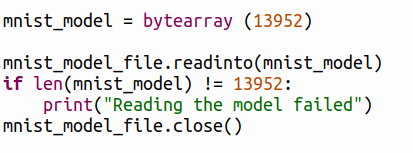
Difference: MicroPythonExamples (1 vs. 3)
Revision 32023-11-08 - UliRaich
| Line: 1 to 1 | ||||||||
|---|---|---|---|---|---|---|---|---|
Running the TensorFlow examples in MicroPython
| ||||||||
| Line: 39 to 39 | ||||||||
| ||||||||
| Added: | ||||||||
| > > | Here is a description of the MicroPython version of the examples: | |||||||
-- Comments | ||||||||
Revision 22023-10-12 - UliRaich
| Line: 1 to 1 | |||||||||||
|---|---|---|---|---|---|---|---|---|---|---|---|
| |||||||||||
| Changed: | |||||||||||
| < < | Running the TensorFlow examples in MicroPython | ||||||||||
| > > | Running the TensorFlow examples in MicroPython
| ||||||||||
| Changed: | |||||||||||
| < < | Article text. | ||||||||||
| > > | The MicroPython interface to TensorFlow is implemented as a module written in C. It contains several Python classes:
Running inference on the ESP32 | ||||||||||
| Changed: | |||||||||||
| < < | -- | ||||||||||
| > > | After having defined and trained the model with TensorFlow, it must be converted into a TensorFlow Lite model, which is an optimized FlatBuffer format identified by the .tflite extension. This file must be transfered to the MicroPython file system. In my examples I create a "models" folder on the ESP32 into which I save the models. You can easily find the size of the model with the ls -l command on the PC. The model is read into a bytearray:
 Once the model is loaded we can create the runtime interpreter:
Once the model is loaded we can create the runtime interpreter:
| ||||||||||
| Added: | |||||||||||
| > > |  Finally the output_callback is called in which you access the output tensor and interpret it.
Finally the output_callback is called in which you access the output tensor and interpret it.
The classes and their resourcestensorThe tensor class has the methods:
The interpreterThe interpreter has methods to get the input and output tensors and for invocation:
| ||||||||||
Comments | |||||||||||
| Deleted: | |||||||||||
| < < | |||||||||||
| \ No newline at end of file | |||||||||||
| Added: | |||||||||||
| > > |
| ||||||||||
Revision 12023-09-07 - UliRaich
| Line: 1 to 1 | ||||||||
|---|---|---|---|---|---|---|---|---|
| Added: | ||||||||
| > > |
Running the TensorFlow examples in MicroPythonArticle text. --Comments | |||||||
View topic | History: r3 < r2 < r1 | More topic actions...
Ideas, requests, problems regarding TWiki? Send feedback